 It’s June which can only mean two things – it’s nearly World Gin Day and I’ve got a Craft Gin Club delivery! Firstly can I say how much I’m enjoying the new branded boxes guys – they look SO much chirpier than the old plain ones! Secondly, this is a bumper box. We have the world exclusive look at the new Warner Edwards Honeybee gin. That’s right, they have chosen the lucky Craft Gin Clubbers as the first people to get their hands on the new addition to their Botanical Garden range. Also in the box is a miniature of their Elderflower Gin, a bottle of Franklin & Sons Lemon Tonic, a bag of Burts Firecracker Lobster crisps and a bar of Mighty Fine Dark Chocolate and Honeycomb. Nom nom nom.
It’s June which can only mean two things – it’s nearly World Gin Day and I’ve got a Craft Gin Club delivery! Firstly can I say how much I’m enjoying the new branded boxes guys – they look SO much chirpier than the old plain ones! Secondly, this is a bumper box. We have the world exclusive look at the new Warner Edwards Honeybee gin. That’s right, they have chosen the lucky Craft Gin Clubbers as the first people to get their hands on the new addition to their Botanical Garden range. Also in the box is a miniature of their Elderflower Gin, a bottle of Franklin & Sons Lemon Tonic, a bag of Burts Firecracker Lobster crisps and a bar of Mighty Fine Dark Chocolate and Honeycomb. Nom nom nom.
brighton
Kelso Gin Company
Note: I contacted the Kelson Gin Company and kindly sent me THREE samples of their gins. As always, you’ll know if I don’t like them.
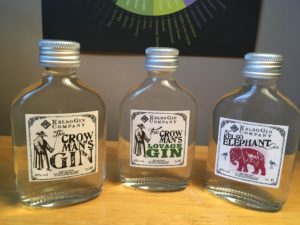 The Kelso Gin Company brings us the first gin from the Scottish Borders. Well, technically they make three gins. Because why start small? Oh, and as well as three gins they also have a vodka and reiver spirit too. Two of their gins are named after The Crow Man – a travelling medicine man who toured the Borders offering “little brighteners” to restore men and soothe women with his mix of secret ingredients. Using organic pure grain and distilled in Kelso, their exact ingredient list is a closely guarded secret (which should make tasting them fun) but the ones they’ll allow us to know include Love Parsely (aka Lovage), juniper and rowan. I have three gins: Crow Man’s Gin (classic juniper with cinnamon, angelica and more), The Kelso Elephant Gin (strong on flavour and using orient spices) and the Lovage Gin (intriguing and fresh).
The Kelso Gin Company brings us the first gin from the Scottish Borders. Well, technically they make three gins. Because why start small? Oh, and as well as three gins they also have a vodka and reiver spirit too. Two of their gins are named after The Crow Man – a travelling medicine man who toured the Borders offering “little brighteners” to restore men and soothe women with his mix of secret ingredients. Using organic pure grain and distilled in Kelso, their exact ingredient list is a closely guarded secret (which should make tasting them fun) but the ones they’ll allow us to know include Love Parsely (aka Lovage), juniper and rowan. I have three gins: Crow Man’s Gin (classic juniper with cinnamon, angelica and more), The Kelso Elephant Gin (strong on flavour and using orient spices) and the Lovage Gin (intriguing and fresh).
Kirkjuvagr Gin
Note: I contacted the Orkney Distillery and they kindly sent me a sample. As always, I’ll let you know if I don’t like it.
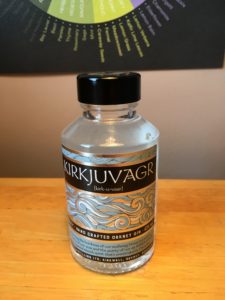 Kirkjuvagr gin comes from the Orkney Distillery – and FYI, is pronounced “kirk-u-vaar”. Kirkuvagr means “church bay” in Old Norse and evolved to be Kirkwall, the island’s capital. The gin is a reflection of the island’s history and the boldness of their ancestors, making a contemporary gin using old ingredients. Angelica grows wild on the island, which is blended with Ramanas Rose, Burnet Rose and Borage and Orkney barley. Distilled in small batches in copper stills, they channel their Norse heritage into every bottle they make.
Kirkjuvagr gin comes from the Orkney Distillery – and FYI, is pronounced “kirk-u-vaar”. Kirkuvagr means “church bay” in Old Norse and evolved to be Kirkwall, the island’s capital. The gin is a reflection of the island’s history and the boldness of their ancestors, making a contemporary gin using old ingredients. Angelica grows wild on the island, which is blended with Ramanas Rose, Burnet Rose and Borage and Orkney barley. Distilled in small batches in copper stills, they channel their Norse heritage into every bottle they make.
Wild Island Botanic Gin
Note: I emailed Wild Island to see if they would send me a sample and they kindly did. I’ll let you know if I don’t like it.
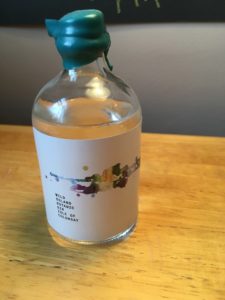 Wild Island Botanic Gin is produced by Colonsay Beverages in the southern Hebrides on the Isle of Colonsay – home to just 120 inhabitants. Distilled with 100% British wheat, it is then infused with 16 botanicals – six of which are sourced locally including lemon balm, wild water mint, meadowsweet, sea buckthorn, heather flowers and the yummy sounding bog myrtle* (Moaning Myrtle spring to mind for anyone else?). The gin was launched in December and has already sold four batches of their gin – but I’m feeling like this is pretty special to have got some outside of Scotland. Wild Island Gin are another Scottish gin to use a beautifully designed label – it features an expressionist watercolour interpretation of the local Kiloran Bay (fun fact: you can buy Harris Tweed lampshades to match the bottles).
Wild Island Botanic Gin is produced by Colonsay Beverages in the southern Hebrides on the Isle of Colonsay – home to just 120 inhabitants. Distilled with 100% British wheat, it is then infused with 16 botanicals – six of which are sourced locally including lemon balm, wild water mint, meadowsweet, sea buckthorn, heather flowers and the yummy sounding bog myrtle* (Moaning Myrtle spring to mind for anyone else?). The gin was launched in December and has already sold four batches of their gin – but I’m feeling like this is pretty special to have got some outside of Scotland. Wild Island Gin are another Scottish gin to use a beautifully designed label – it features an expressionist watercolour interpretation of the local Kiloran Bay (fun fact: you can buy Harris Tweed lampshades to match the bottles).
Juniper Green Organic Gin
 Hi, I’m Jenny and a few weeks ago I went to a Vegan Festival. As a former vegetarian that has since seen the error of her ways and now eats steak at every opportunity, it was strange (I actually wrote about it for Brighton Girl over here). However, I did as I do best and found myself chatting to a gin maker. Juniper Green Organic Gin can trace its roots back to 1700, using over 300 years of experience to make their current blend. Juniper Green is 100% gluten free, distilled using organic and sustainable crops – the juniper is FairWild meaning that the berries from Bulgaria are collected in a sustainable way and those harvesting get paid a fair and proper wage. The angelica and summer savoury are grown in the UK by the Organic Herb Trading Company especially for this gin. The grain is made and distilled on a single estate which has been organic for 35 years. Basically, it’s good for the environment to drink it, and therefore good for you… that works right? So after a long chat with the sellers, I got myself a bottle of the 43% gin (after having a good taste of their various rums as well!).
Hi, I’m Jenny and a few weeks ago I went to a Vegan Festival. As a former vegetarian that has since seen the error of her ways and now eats steak at every opportunity, it was strange (I actually wrote about it for Brighton Girl over here). However, I did as I do best and found myself chatting to a gin maker. Juniper Green Organic Gin can trace its roots back to 1700, using over 300 years of experience to make their current blend. Juniper Green is 100% gluten free, distilled using organic and sustainable crops – the juniper is FairWild meaning that the berries from Bulgaria are collected in a sustainable way and those harvesting get paid a fair and proper wage. The angelica and summer savoury are grown in the UK by the Organic Herb Trading Company especially for this gin. The grain is made and distilled on a single estate which has been organic for 35 years. Basically, it’s good for the environment to drink it, and therefore good for you… that works right? So after a long chat with the sellers, I got myself a bottle of the 43% gin (after having a good taste of their various rums as well!).
Lilliput Dorset Gin
Note: I contacted Andy from Lilliput gin before they launched and since their launch, he kindly sent me some goodies to try. As always, I’ll let you know if I don’t like it.
 Lilliput Dorset Gin is new. Like, brand new. They started experimenting in January 2017, and by the end of April 2017 have launched their first product. I’m a big fan of their ethos and they work with an emphasis on quality, clarity and escape. They work in collaboration with local small businesses and entrepreneurs and promote their homeland of Dorset with pride. Distilled in their microdistillery using home-grown organic Rosemary, organic Basil from Egypt, organic Thyme from Spin and organic Kalamata olives from Greece, you get a sense they like the organic thing. The four botanicals are infused separately then blended together with Juniper from Bosnia (amongst a few others).
Lilliput Dorset Gin is new. Like, brand new. They started experimenting in January 2017, and by the end of April 2017 have launched their first product. I’m a big fan of their ethos and they work with an emphasis on quality, clarity and escape. They work in collaboration with local small businesses and entrepreneurs and promote their homeland of Dorset with pride. Distilled in their microdistillery using home-grown organic Rosemary, organic Basil from Egypt, organic Thyme from Spin and organic Kalamata olives from Greece, you get a sense they like the organic thing. The four botanicals are infused separately then blended together with Juniper from Bosnia (amongst a few others).
Stirling Gin
Note: I found Stirling Gin on Twitter and they kindly sent me a sample. As always, you’ll know if I don’t like it.
 For those that don’t know, I’m half Scottish. I love Scotland – especially this year when McLaren pride will peak in August when our clan marches in the final night of the Tattoo. I also love gin. So Scottish gin is a winner for me. Introducing yet another new Scottish gin, Stirling Gin was first distilled on 28 October 2015. They use local nettles which are distilled with basil, lemon and orange peel, juniper and angelica root to create their gin in Annie – the 450 litre copper still. They place some botanicals directly in the pot, and the nettle and basil are placed in a basket at the top. They list a number of recommended serves, including some fruity cocktails.
For those that don’t know, I’m half Scottish. I love Scotland – especially this year when McLaren pride will peak in August when our clan marches in the final night of the Tattoo. I also love gin. So Scottish gin is a winner for me. Introducing yet another new Scottish gin, Stirling Gin was first distilled on 28 October 2015. They use local nettles which are distilled with basil, lemon and orange peel, juniper and angelica root to create their gin in Annie – the 450 litre copper still. They place some botanicals directly in the pot, and the nettle and basil are placed in a basket at the top. They list a number of recommended serves, including some fruity cocktails.
Greensand Ridge Gin
Note: I found Greensand Ridge and emailed them to politely ask for a sample, Will Edge (the distiller) kindly agreed and here we are.
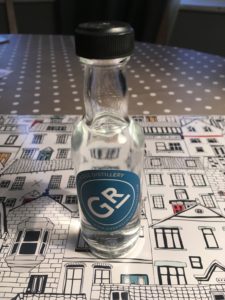 If you go down to the woods today, you’re sure of a big surprise. That surprise being the Greensand Ridge Distillery on the Sussex/Kent border which not only produces gin from an old Victorian Coach House, but also lets you do distillery tours and even hire their space out for your next event (#eventprofs take note). Eight of the botanicals are grown within a mile of the distillery and these are blended with some of the classics to create their premium London Dry gin. Local botanicals include cobnuts, gorse (for that vanilla/coconut scent), honey (for sweetness), poppy seeds (for warmth) and bay laurel (for a woody sweetness). The ethos behind the distillery also helps to reduce waste and the environment. They try to limit wastage by fermenting produce that supermarkets won’t use, don’t use chemicals to clean their equipment, power their still from sustainably sourced electricity and reusing or recycling 100% of their packaging materials.
If you go down to the woods today, you’re sure of a big surprise. That surprise being the Greensand Ridge Distillery on the Sussex/Kent border which not only produces gin from an old Victorian Coach House, but also lets you do distillery tours and even hire their space out for your next event (#eventprofs take note). Eight of the botanicals are grown within a mile of the distillery and these are blended with some of the classics to create their premium London Dry gin. Local botanicals include cobnuts, gorse (for that vanilla/coconut scent), honey (for sweetness), poppy seeds (for warmth) and bay laurel (for a woody sweetness). The ethos behind the distillery also helps to reduce waste and the environment. They try to limit wastage by fermenting produce that supermarkets won’t use, don’t use chemicals to clean their equipment, power their still from sustainably sourced electricity and reusing or recycling 100% of their packaging materials.
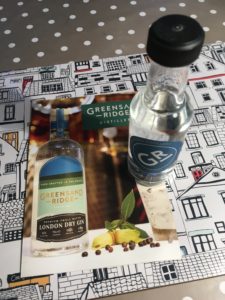 Cracking open my little bottle, it smells light and citrusy. A hint of fresh woodiness (like a pine tree) and it smells like a right treat. Opened out in the glass, the alcohol smell comes to the front and I initially had to retreat slightly. As I have a 50ml sample, I’m trying this straight and going into the G&T, no watering down this time. It’s very warm and woody, reminiscent of a Burleigh’s – although I don’t think I’m going to cry and get homesick this time.
Cracking open my little bottle, it smells light and citrusy. A hint of fresh woodiness (like a pine tree) and it smells like a right treat. Opened out in the glass, the alcohol smell comes to the front and I initially had to retreat slightly. As I have a 50ml sample, I’m trying this straight and going into the G&T, no watering down this time. It’s very warm and woody, reminiscent of a Burleigh’s – although I don’t think I’m going to cry and get homesick this time.
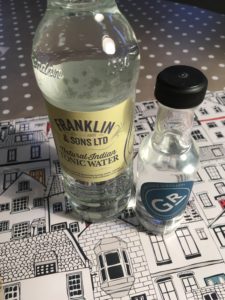 Mixed with a Franklin and Sons tonic, it retains it’s earthy and woody quality. A slight sweetness lifts it at the back of the tongue and it’s certainly refreshing. The citrus notes that I sensed at the beginning have all but disappeared. It tastes slightly thick – I think a result of the vanilla-ey gorse and the honey.
Mixed with a Franklin and Sons tonic, it retains it’s earthy and woody quality. A slight sweetness lifts it at the back of the tongue and it’s certainly refreshing. The citrus notes that I sensed at the beginning have all but disappeared. It tastes slightly thick – I think a result of the vanilla-ey gorse and the honey.
A bottle of 40% gin is available on Master of Malt for £34.95 (at time of writing). I’m not 100% convinced I would buy this, I’m more of a bold lemon flavours kinda gal. You can find Greensand on Instagram and Facebook.
I love me a local gin – have you spotted any more from around Sussex that you think I should try? Let me know on Twitter and Instagram.
Conker Gin
Note: I’ve heard good things about Conker Gin so I got in touch and they kindly sent me a sample. I’ll let you know if it doesn’t live up to the hype.
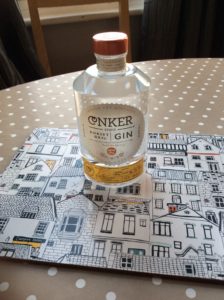 Conker Gin hails from Dorset – Bournemouth to be precise. To me, Bournemouth is the place of child hood holidays, feeding squirrels by hand, swimming pools, dirty beaches and my sister hiding in a hedge pretending to be a velociraptor. Don’t ask. Conker combine juniper with elderberries, samphire and gorse flowers from nearby New Forest. I’m expecting a slightly floral gin with a hint of salt and seaside. Conker also produce a Cold Brew Coffee Liqueur made from Dorset’s very own Beanpress Coffee Co. for anyone looking for an authentic coffee liqueur.
Conker Gin hails from Dorset – Bournemouth to be precise. To me, Bournemouth is the place of child hood holidays, feeding squirrels by hand, swimming pools, dirty beaches and my sister hiding in a hedge pretending to be a velociraptor. Don’t ask. Conker combine juniper with elderberries, samphire and gorse flowers from nearby New Forest. I’m expecting a slightly floral gin with a hint of salt and seaside. Conker also produce a Cold Brew Coffee Liqueur made from Dorset’s very own Beanpress Coffee Co. for anyone looking for an authentic coffee liqueur.
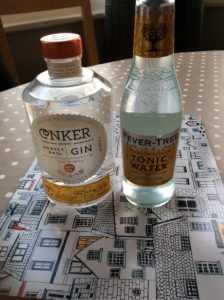 Opening the bottle (screw top) it smells quite lemony and floral. Mixed with some water in a copa glass it is very soft and gentle, a hint of juniper and not much else. But not in a boring bland way. This is light, slowly dancing across your tongue.
Opening the bottle (screw top) it smells quite lemony and floral. Mixed with some water in a copa glass it is very soft and gentle, a hint of juniper and not much else. But not in a boring bland way. This is light, slowly dancing across your tongue.
Mixing it up with some Fever Tree tonic, this keeps its lightness and its freshness. Again, no one flavour stands out but this is far from plain. I instantly want to be sat outside in the sunshine with a BBQ on Brighton beach (BBQ responsibly people). This is a classic gin. I love this. I’m so happy I’ve finally been able to try it. Is it slightly pricy for an every day gin? Perhaps. However, I think this is worth it. You know how some gins go OTT with the fancy flavours and kinda ruin it? This is a simple gin, executed to perfection. This has really picked up my day (my 10k run is three days away and I currently have two strapped up ankles, so that should be fun).
Conker Spirits are available on Master of Malt for £35.95 and you can contact Conker on Twitter and on Facebook.
Let me know what gin I should be trying next on Twitter and Instagram.
Salcombe Gin
Note: After my colleague Lorraine told me about a new gin from Salcombe, I emailed them to give it a try. I’ll let you know if I don’t like it.
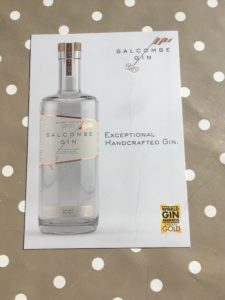 It’s not just Scotland that is producing new gin, for today’s blog we turn south west to Salcombe in South Devon. Salcombe Gin is distilled using a wheat spirit and blended with water from Dartmoor, using thirteen botanicals. They take craft gin to a new level – they hand peel their grapefruits, lemons and limes on the morning of distillation to ensure they capture the oils at their best. The citrus is balanced by floral notes from chamomile and bay leaf with some added juniper, peppery heat from Cubeb berries and warmth from the cinnamon. All of the flavours come together to make the Devon Dry gin – imagine a London dry gin with added sunshine.
It’s not just Scotland that is producing new gin, for today’s blog we turn south west to Salcombe in South Devon. Salcombe Gin is distilled using a wheat spirit and blended with water from Dartmoor, using thirteen botanicals. They take craft gin to a new level – they hand peel their grapefruits, lemons and limes on the morning of distillation to ensure they capture the oils at their best. The citrus is balanced by floral notes from chamomile and bay leaf with some added juniper, peppery heat from Cubeb berries and warmth from the cinnamon. All of the flavours come together to make the Devon Dry gin – imagine a London dry gin with added sunshine.
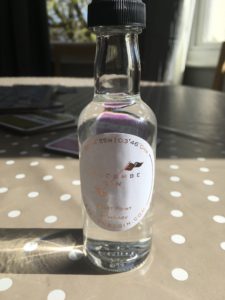 Cracking open my sample bottle it smells delicious. Floral and citrus with a bit of warmth coming from the cinnamon, and in the glass the juniper becomes more prominent. As I only have 50cl I’m going for my ginvent approach and having a wee nip straight which is slightly spiced. And because I’m not used to drinking it neat I did a rather ridiculous recoil as the heat of the alcohol hit my tongue. As they also kindly sent me a bottle of Fever Tree to try it with, it would be silly of me not to use it.
Cracking open my sample bottle it smells delicious. Floral and citrus with a bit of warmth coming from the cinnamon, and in the glass the juniper becomes more prominent. As I only have 50cl I’m going for my ginvent approach and having a wee nip straight which is slightly spiced. And because I’m not used to drinking it neat I did a rather ridiculous recoil as the heat of the alcohol hit my tongue. As they also kindly sent me a bottle of Fever Tree to try it with, it would be silly of me not to use it.
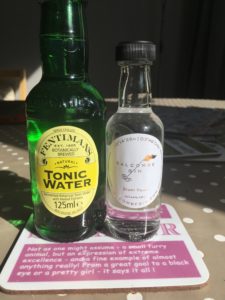 It’s different. The spice counteracts the floralness of it, and there’s a certain sweetness at the back of the mouth. It’s very dry on the front of the tongue. There’s something ever so slightly chemically in the smell when you’re drinking it, but this doesn’t translate to the taste. It hints at traditional but with some added zest – I think this is a perfectly modern gin to enjoy by the seaside. Although, then again, what isn’t best enjoyed in the sun?
It’s different. The spice counteracts the floralness of it, and there’s a certain sweetness at the back of the mouth. It’s very dry on the front of the tongue. There’s something ever so slightly chemically in the smell when you’re drinking it, but this doesn’t translate to the taste. It hints at traditional but with some added zest – I think this is a perfectly modern gin to enjoy by the seaside. Although, then again, what isn’t best enjoyed in the sun?
A 70cl bottle of 44% gin is available on their website for £37.50. You can find Salcombe Gin on Facebook, Twitter and Instagram.
Have you tried Salcombe Gin? Or any gin from your holidays? Let me know on Twitter and/or Instagram.